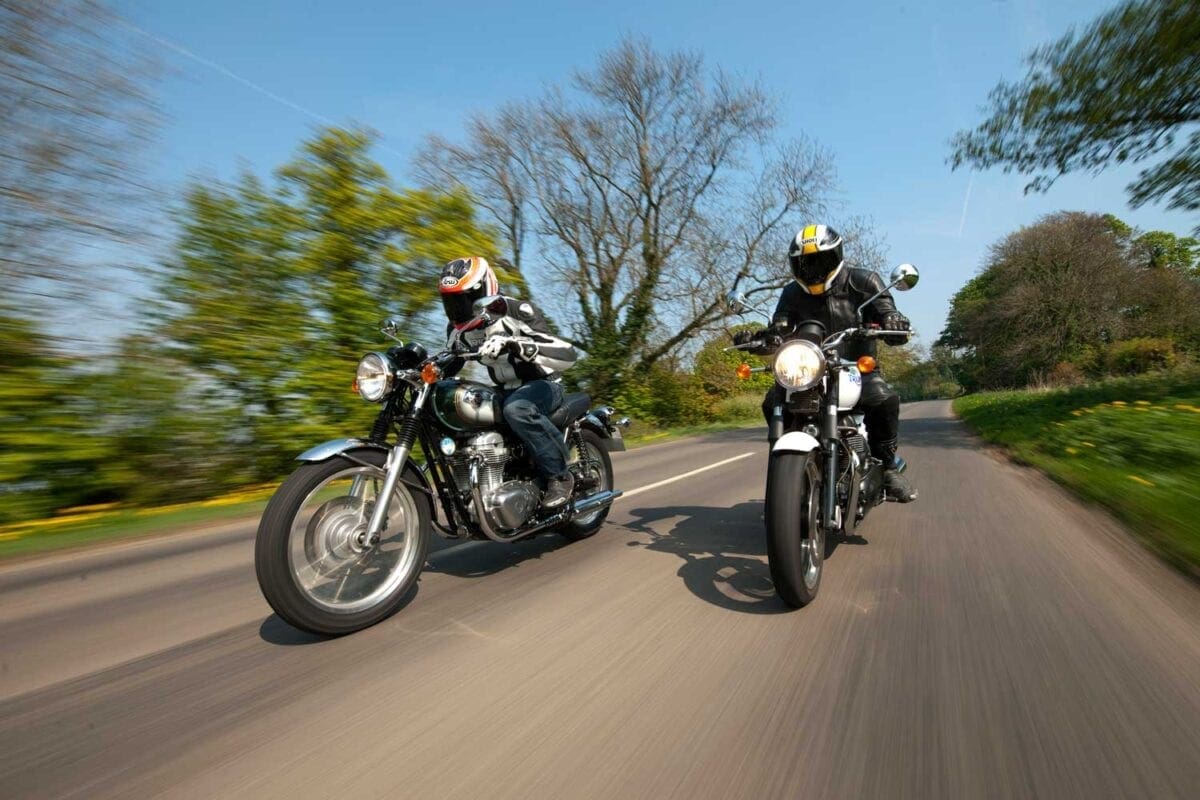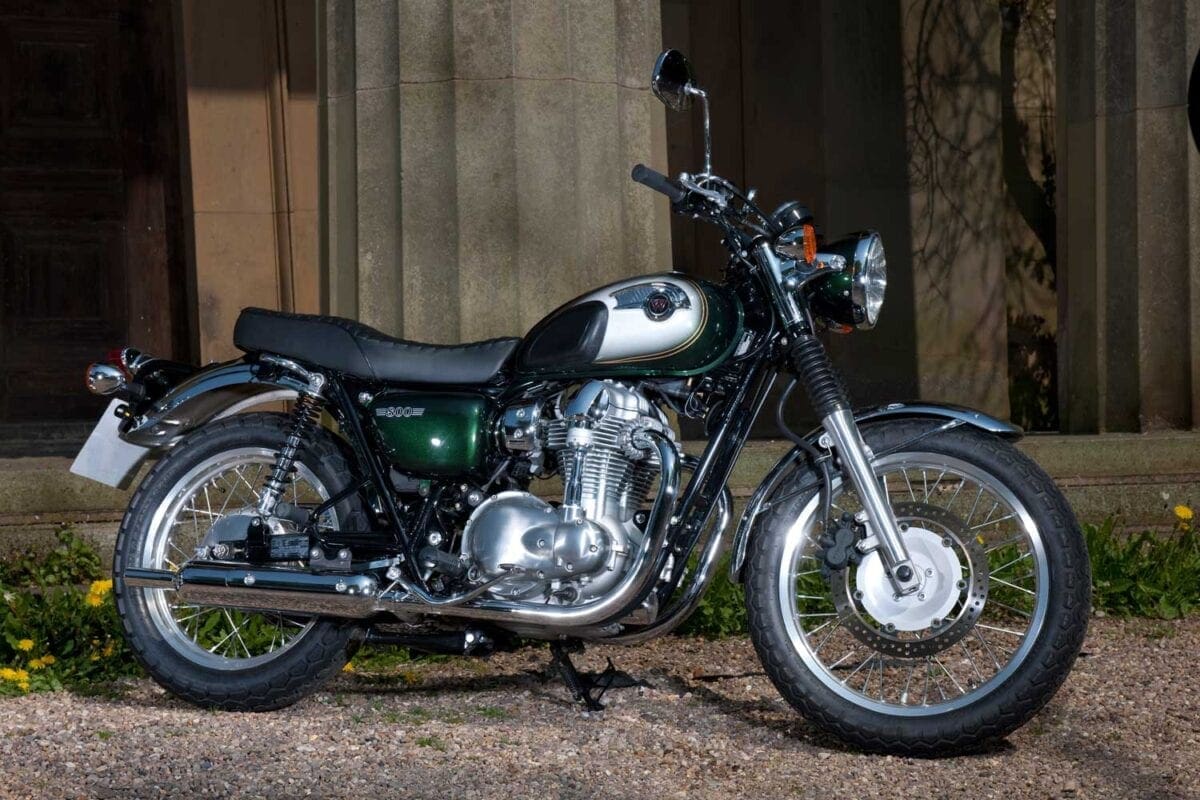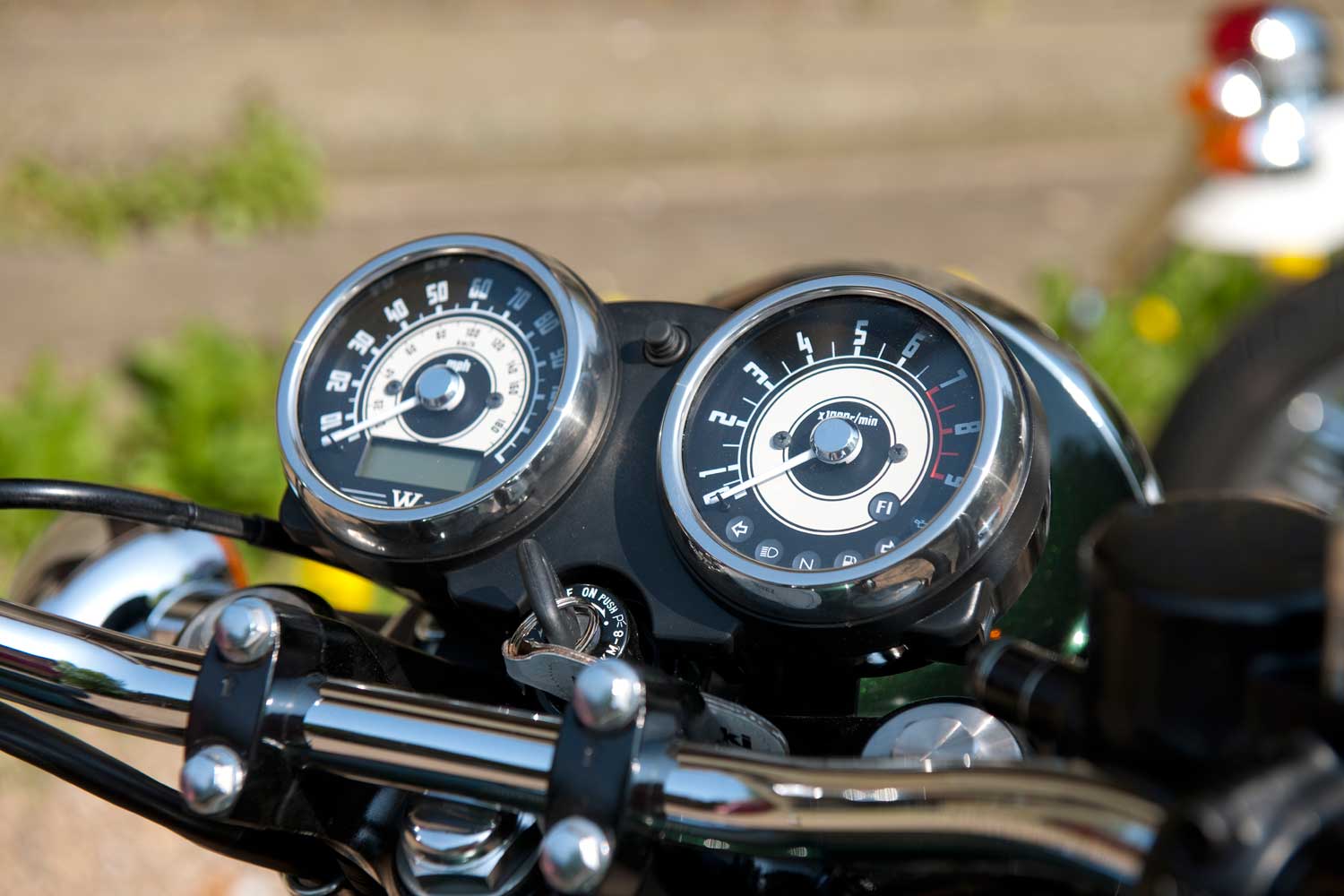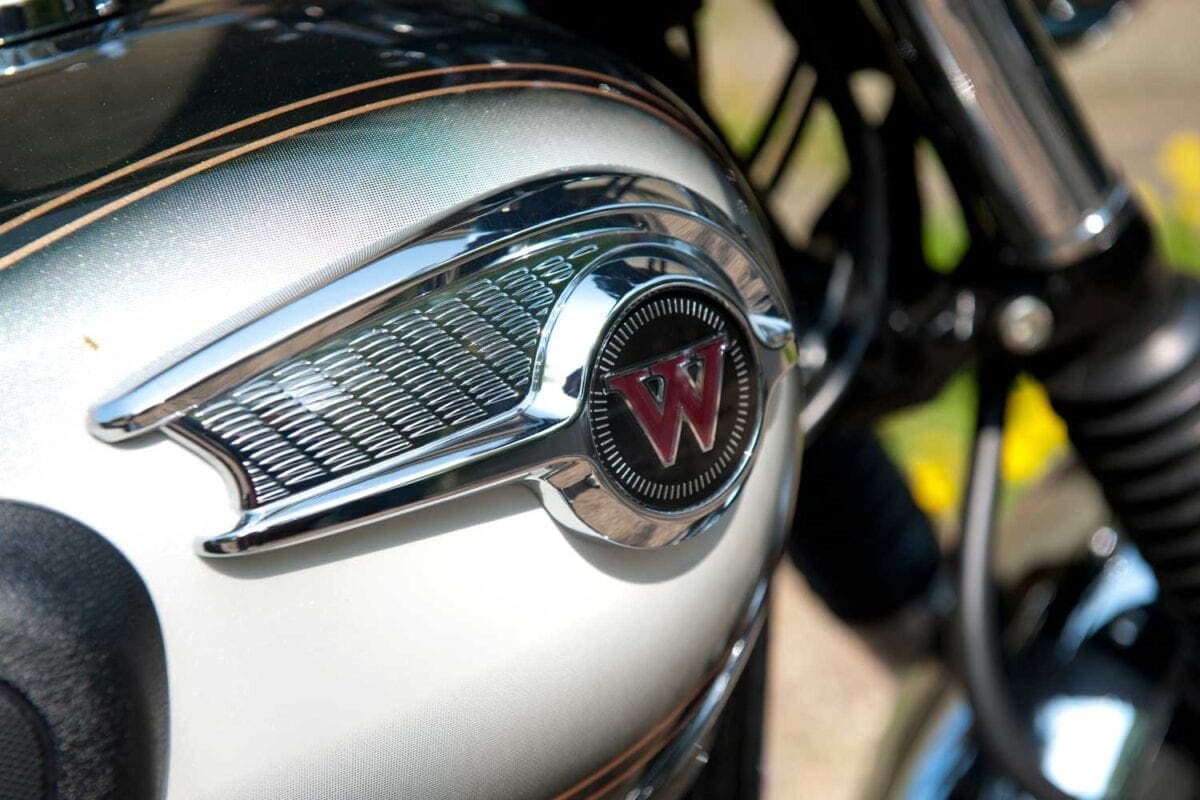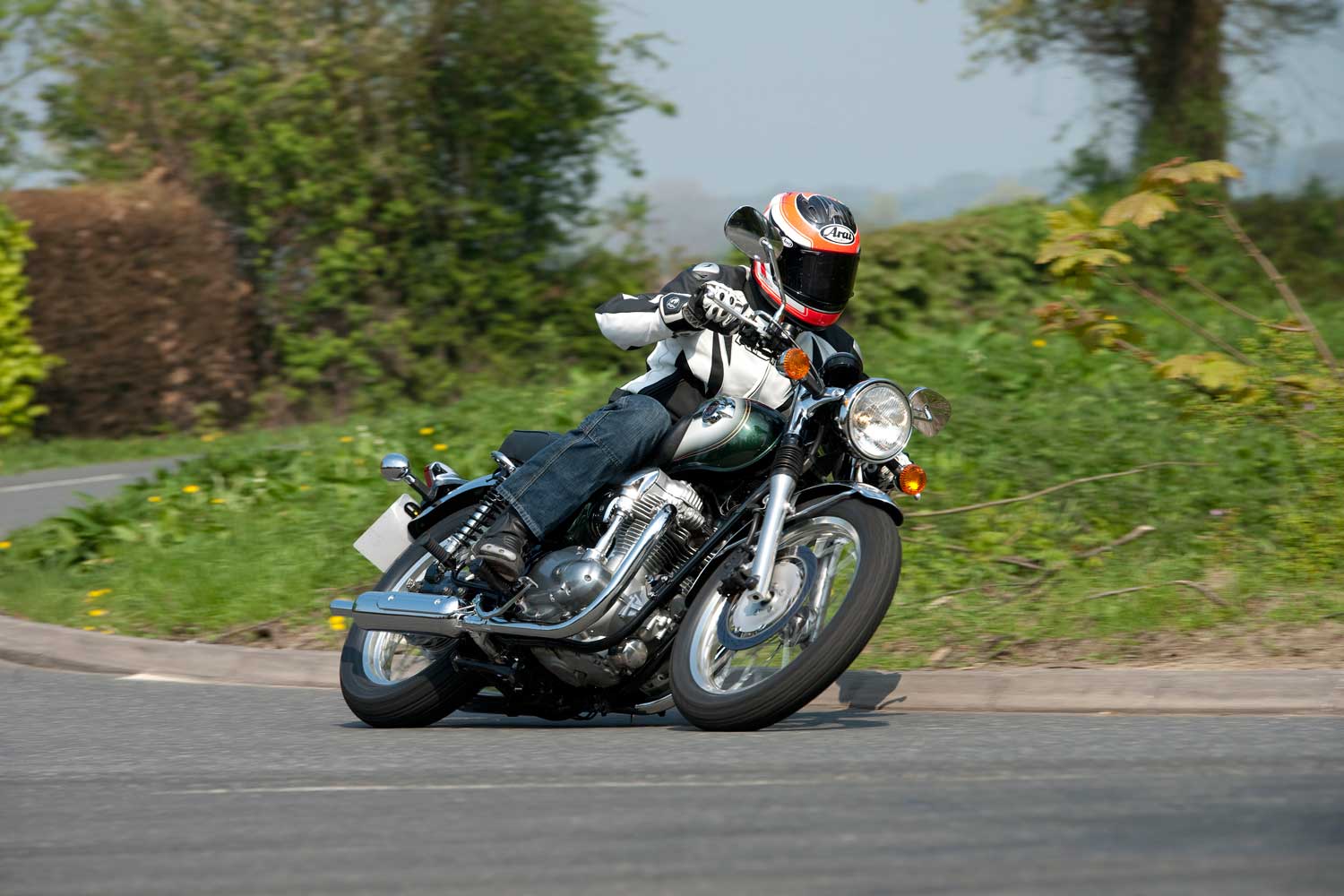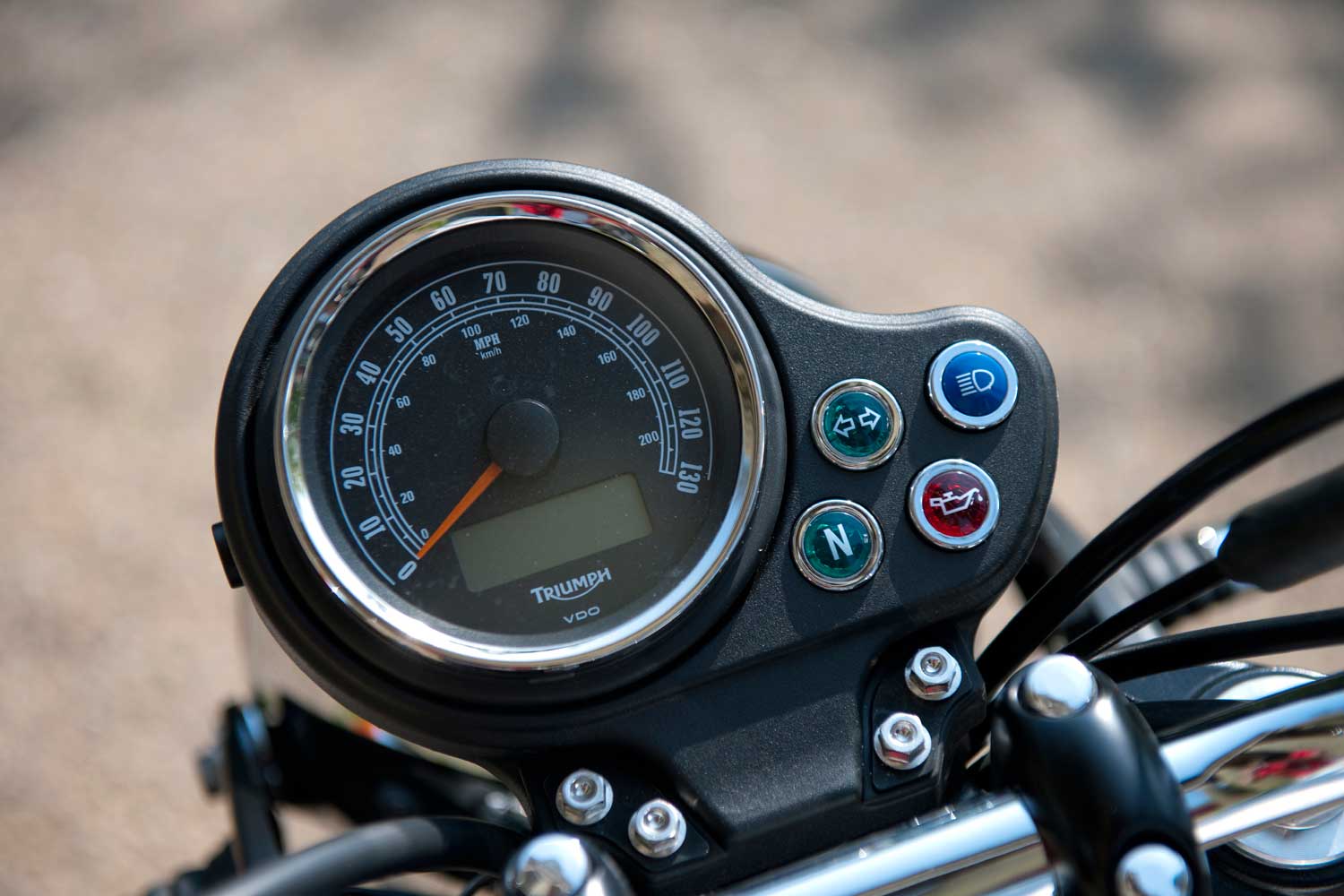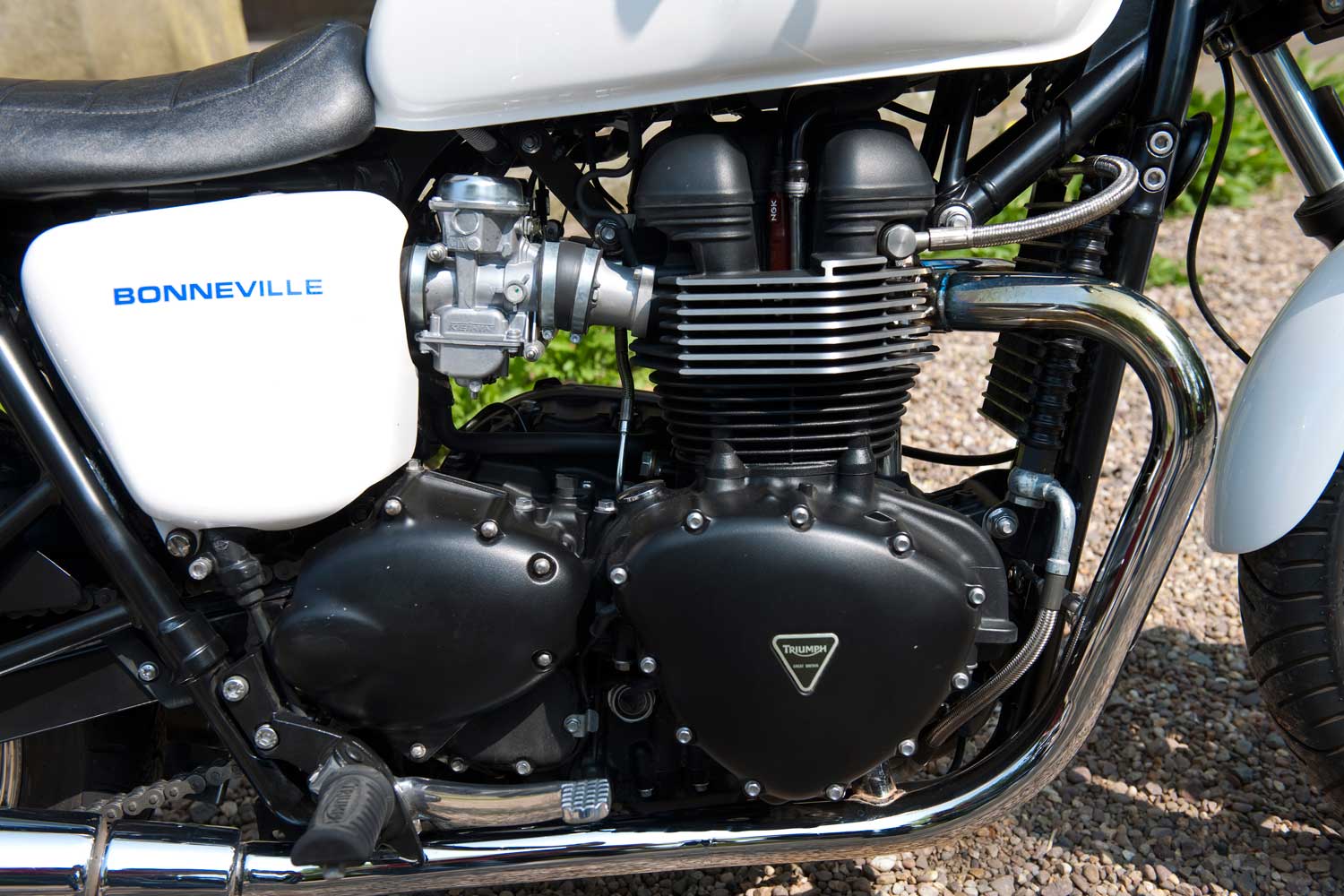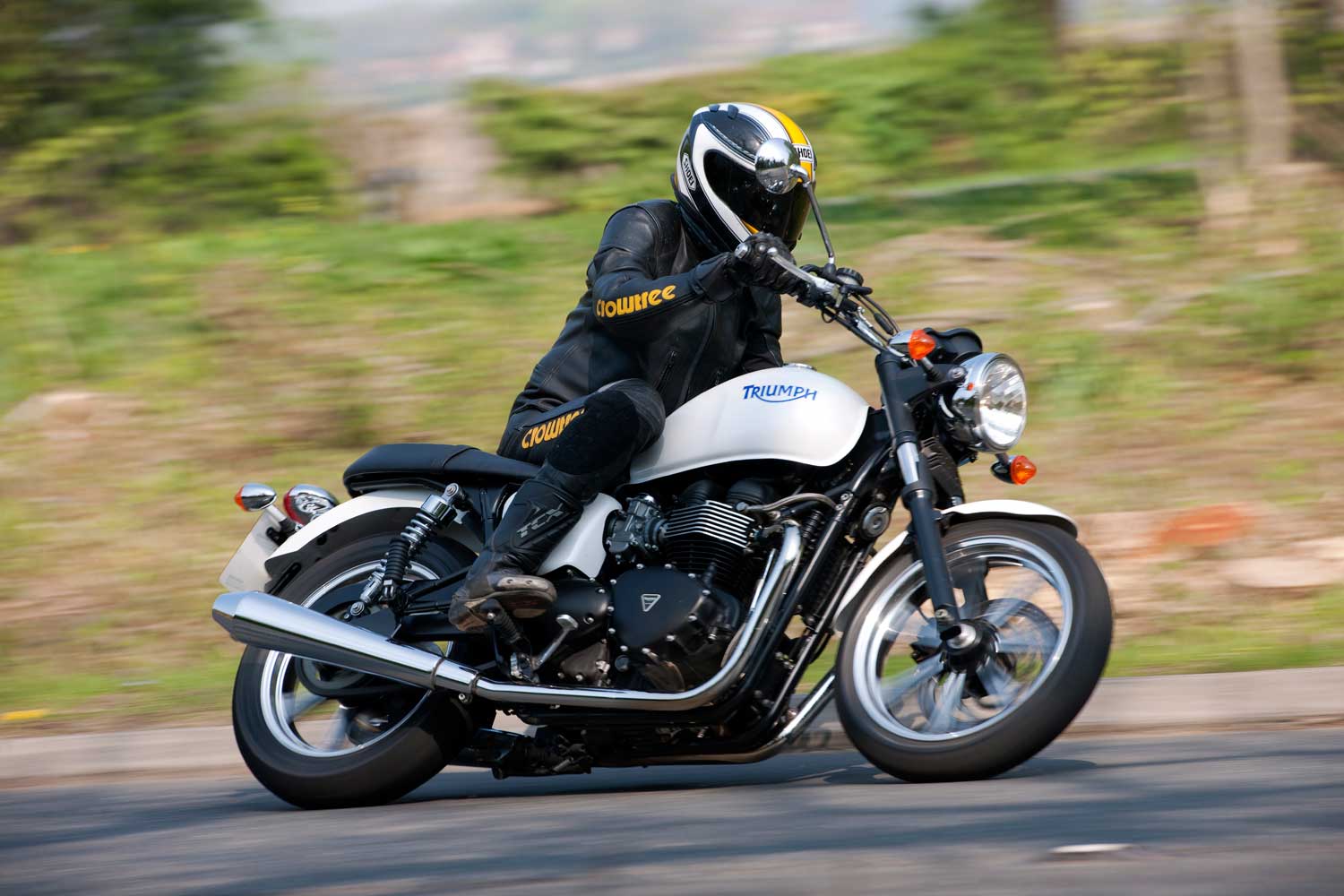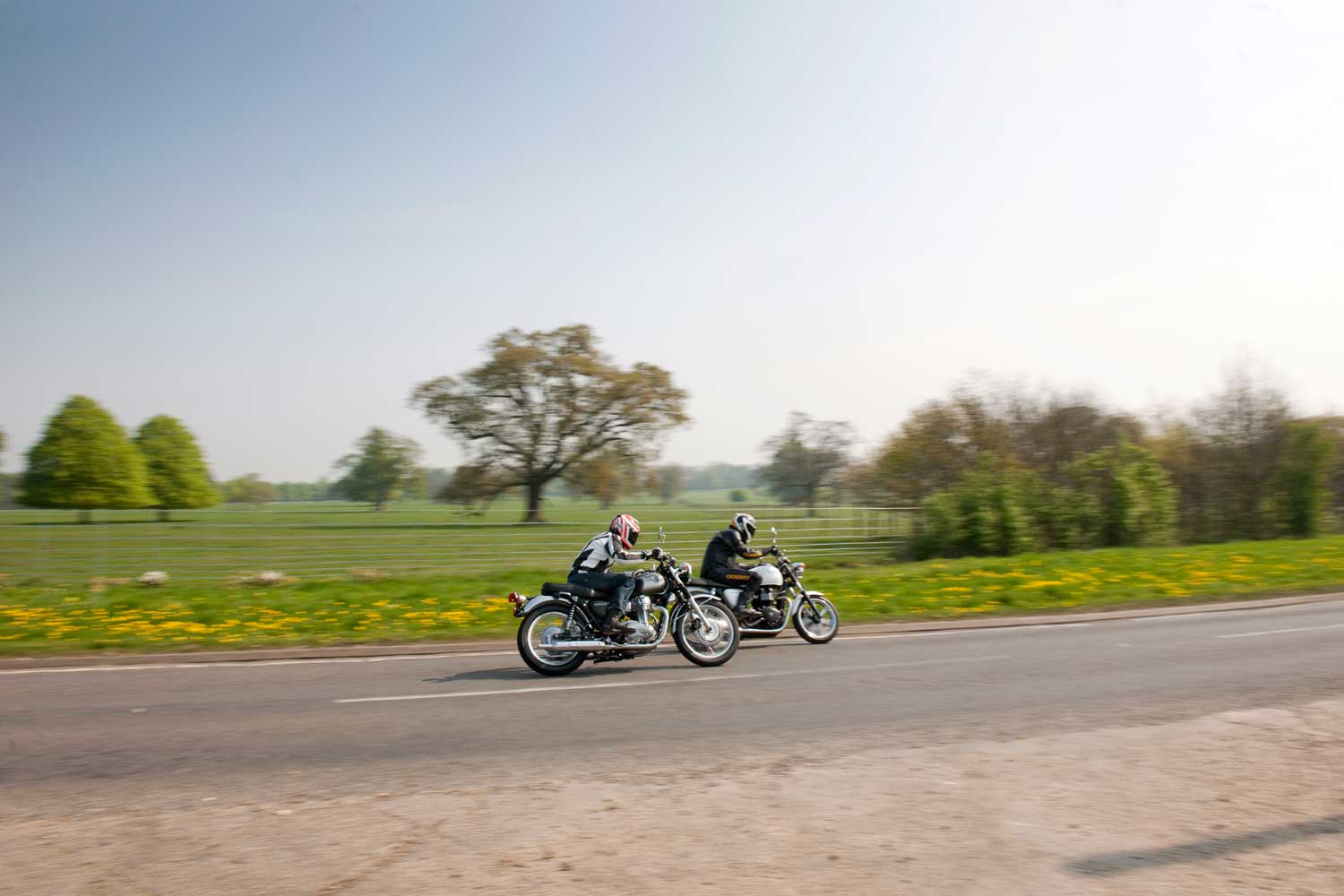Kawasaki W800 vs Triumph Bonneville: Two modern retro-styled roadsters, and great bikes in their own right or a poor nod to a time gone by? Steve Rose and Bruce Wilson took used examples from 2011 for a ride to find out…
Steve’s ride on the Kawasaki W800
It’s 6am somewhere in middle England. The sound of a lone motorcycle bounces off the hills. To any one of the older locals in a dozen sleepy villages it sounds like an old BSA or Triumph (admittedly with a large-Euro-bung reducing the exhaust note to a whisper). To the middle-aged bloke who’s riding it, the hoot-sickle in question is simply a right bloomin’ giggle.
That bloke is me, heading cross country to a bike show. It’s sunny, almost warm and we’ve ridden nearly 40 miles without seeing another vehicle. One of those rides that flicks the switch from ‘good day’ to ‘memorable’. It feels like going back in time. Empty roads and a thrumming British twin beneath me. Is this what 1960s biking felt like? King of the empty roads.
Except the bike isn’t British, it’s Japanese, but the feeling is very, very authentic. Much more so than the Hinckley Bonneville, which is a terrific modern bike dressed in a retro T-shirt. The Kawasaki W800 picks up its revs slowly, follows every imperfection in the road and occasionally makes you worry the rear wheel bearings might be worn. It sits down on its shocks, wags its bars, needs effort to make it turn and a firm hand to stop.
If we were judging the W800 as a modern bike all this stuff would be a problem, but as a recreation of the 1960s Brit experience, you have to hand it to Kawasaki for attention to detail. All it needs is an oil leak and less reliable electrics. I’m not being sarcastic, I am genuinely impressed. I love the idea of a bike that feels like an old bike – something with proper character, not just a sewing machine clone. Something that makes you ride it differently and think about its limitations before just barrelling into a corner. Something that encourages you to ride at cruising speed which in turn makes you enjoy the experience even more.
The whole of this trip has so far been ridden at no more than 70mph. Mostly a bit less than that because the Kawasaki’s natural speed – that place where all the natural vibes and resonances come together, the place you end up riding when you don’t watch the speedo – is about 65mph in top. At this pace pretty much every bend can be taken without backing off, every tighter corner can be taken without braking. Roll off the throttle, down a gear and that’s enough to drive through the tighter ones at around 45mph. Relaxed and confident – I’m used to the back wheel shimmy by now.
Later on I discover that the engine is deceptive. Up the pace to 80mph, in a hurry and it only takes a few minutes before this feels comfortable too (although the chassis is a lot less happy) and there‘s surprisingly good acceleration in top gear. Later still, when the fuel light comes on after 120 miles, it only takes nine litres which means around 60mpg (and a gallon or so still left in the 14 litre tank).
The more I ride it, the more I like it. No surprise really because I always liked the old W650. That bike had a couple of years to itself in the market before Triumph revamped the Bonneville, but it was a good bike in its own right (and successful too).
The new one has a bigger engine but not much more go. Most of the extra power has been sapped by the restrictive emissions kit fitted. Likewise, the other big change – swapping the 650’s carbs for fuel injection was all about emissions, not efficiency. Triumph made a great job of this in 2009 by building the injectors into fake carb bodies. Kawasaki’s injection looks messy with exposed wires and block connectors behind a small chromed cover.
It’s a recurring theme on the W800. Some bits – the engine, the rear drum brake, chromed metal mudguards and peashooter exhausts – are just beautiful. Others – the tacky Triumph-like tank badges and Smiths-tribute clocks – don’t work so well.
Close to Stafford now, the last 15 miles are faster, twistier and busier. Two bikes flash past, a GSX-R-something-or-other and a Kawasaki Versys. They break my concentration and shatter the dream. Forty-six-year-old bloke becomes 26-year-old lone wolf with something to prove and for reasons I still don’t understand, I ask the W800 for enough performance to go hunt some sports bikes. Obviously (or I wouldn’t be telling you), I pass them just before Stafford: obviously, they didn’t know we were racing so it wasn’t really a fair fight. So the W800 can cut it. At £6649 it’s well priced for its spec (see Uncovered boxout) and, if the 650 is anything to go by, depreciation will be slight. I suspect that many will see it as the starting point. Building blocks for a Brit-based special cafe racer or flat track replica. Cheaper and less offensive to the purists than stripping a bona fide classic.
The Kawasaki is a bit like the Japanese cruisers that look too much like Harleys. Kawasaki always did those bikes best too, so it’s no surprise such a good job has been done with this one, but sometimes I wish the Japanese would accept that ‘heritage bikes’ (which is what these things are after all), are done best by those with the heritage. If Kawasaki wants to be authentic and remind us about its own heritage (and it worked last time with the Zephyrs), then please make the next ’W’ machine a 750cc two-stroke triple. No, really. Right now you’ll sell every one you build.
Bruce’s second opinion: Kawasaki W800
The styling’s well before my time, and it goes against the grain of every bike I’ve ever liked, but I can’t help feeling drawn to the Kawasaki. In a word, it’s cool and incredibly well finished. The type of bike you can ride around on casually, confident that everyone within eyesight is gawping at you trying to figure out what it is you’re on. You know that when you go back to wherever you’ve parked it there will be a queue of people ready and waiting to fire questions at you. Yes, it really does look that good.
But when it comes to riding the W800, that beautiful picture I’ve just painted for you fades a little. The single disc front brake needs a firm hand; it’ll stop you but it’s advisable to start squeezing on both the front and rear anchors well in advance on approaching junctions. Ground clearance is another thing the bike’s lacking in and that’s not helped by the lightly sprung, soft suspension, which will kick the bike off in a mini tank slapper if you try to change direction quickly at higher speeds.
But slow things down a bit and the upright riding position, wide-enough bars and laid back feel complement the air-cooled, 773cc twin well. The engine’s easy to gel with for novice and experienced riders alike – responsive enough, it never seems to run out of grunt and you’ll find your left foot aches from subconsciously trying to change up the bike’s gearbox long after you’ve selected the fifth and final gear.
EFI fuelling ensures the power delivery is smooth and economical too. I got a return of 57mpg riding at a constant 70mph and even two-up with my dad on the back the figure only slumped to 50mpg. That did impress me, but I still felt let down by the bike’s overall performance. If only looks were everything.
Editor’s note: It’s interesting to find Bruce, in his mid-twenties, loving the W800’s retro-inspired looks but not so much the entire package on offer.
As well as the older classic bike enthusiast, Kawasaki is apparently trying to aim this bike at younger riders (under-30s), which is exactly where Bruce fits in.
Arguably he’s had more experience than most riders of his age having raced at BSB level, so younger riders who have just ridden on the roads probably won’t find the W800’s weaker points as much of an issue. Also, many of these riders won’t be bothered by the ‘reproduction’ tag as maybe some of their dads would be, and like the W800 for what it is – a modern, authentic enough bike that looks great and shouldn’t leave you stranded like a machine 30 years its senior sometimes can.
Bruce’s ride on the Triumph Bonneville
Some rides are more memorable than others… like my first time out on Triumph’s Bonneville. Unsuspecting and naïve to the true calibre of the Hinckley-made retro classic, I’d psyched myself up for a 50-mile commute home across the Lincolnshire Wolds at pushbike pedal-power pace, being overtaken by rabbits and pheasants in their scurries to outrun the local farmer and his combine.
Naturally, the handling was going to be a little sloppy, the brakes bordering on non-existent and the power somewhat lacking in the oomph department. But at least I could be confident in looking good. Because regardless of how the bike was set to perform physically, the parallel-twin certainly looked the part with its traditionally styled wide handlebars, low-slung exhaust, twin carbs (actually carb outers, concealing modern day fuel injectors within), and just enough chrome in all the right places to get the local magpies excited.
Yes, Triumph has worked its magic in recreating a convincing classic reproduction and, to the untrained eye, a machine capable of being confused at first glance with a latter day Meriden T140 special. It was even spec’d up with a similar design of cast wheels, engine case shapes and disc brakes – guaranteed to take you back to that nostalgic mid-1970s period of motorcycling faster than a time machine.
True, a kick-start would have been a nice aesthetic addition, but unnecessary considering the contemporary Bonnie’s fitted with a leccy boot. Times have moved on and I grasped that the instant I set off on my journey home. By the time I’d negotiated the local rat run and made my way to the twisties, I’d all but sold my soul to the riding experience. The Bonneville handles sublimely, hitting apexes like they are going out of fashion and changing direction faster than a politician’s referendum.
The Kayaba suspension may have appeared primitive in design (the front end had no adjustment whatsoever and the rear twin shocks could only be altered by limited turns of spring preload) but proved more than capable for the bike’s (and my) needs, working well with the tubular steel chassis to produce an assured feeling of planted wheels at most angles of lean.
To get the pegs down took some serious dedication to cornering, thanks to their neatly raised and forward mounted position. They were comfortable too (for me at 5ft 9in), along with the position of the swept handlebars and softly sprung seat.
Now onto the straighter parts of the run, and the time had come to get a true appreciation of the 865cc twin’s output, which had already impressed me with its abundance of low down torque and smooth fuelling. Needless to say, triple figures were not outside the Bonnie’s potential but riding at those types of speeds made you feel like you were grabbing onto the side of an aeroplane’s wing, holding on for your life. In fact, that sensation started to build after you’d hit 70mph, amplifying dramatically with the addition of every 10mph. But that’s not the point of this bike. The feeling of being buffeted around by the wind adds credibility to the classically themed experience, encouraging you to ride slower and take in more of the roads you’re traversing.
Lower speeds also allowed you to listen to the bike’s throaty exhaust notes, which make the W800 sound like a bunged-up sewing machine. If you time the Bonneville’s downshifts correctly you’re rewarded with a raucous burble which will see everyone’s head turning in your direction, desperately trying to work out whether that noise really could have come from that little, ‘old’ bike?
The word fun doesn’t do this bike justice. It ticks every box, including the one on the £6149 price tag. Yes, it’s not only better all-round than the Kawasaki, it’s also several hundred pounds cheaper and far more authentic thanks to the brand’s history.
Editors note: Regarding the price difference between the Bonneville and W800, it’s worth noting that the W800 is better spec’d up than the base Bonnie. The Bonneville T100, complete with twin dials, spoked wheels, two-tone paint, fork gaiters, rubber knee pads, chrome engine covers etc, is nearer the W800’s spec for similar money.
Steve’s second opinion: Triumph Bonneville
Can I tell you a secret? This is my favourite bike of the year so far. On paper the Bonnie does nothing special. Underpowered for an 865cc bike, slightly too heavy, basic suspension, not enough brakes and styling that’s maybe just a little too rounded. Like a proper Bonnie viewed through the bottom of a bottle.
And then you ride it and find that there’s just enough power, plenty of brakes, reasonable ride quality and a chassis that steers better than any other road bike you’ve ridden for ages. Excuse me? Did I read that right? Yes. Don’t ask me why or how – the Bonnie defies high tech explanations because there isn’t any high tech on it (okay, apart from the fuel injection cunningly disguised to look like carbs). But, on my favourite B-roads and a half dozen other unknown ones, it steers and holds a line like no other bike I’ve ridden for ages.
It’s hard to describe, other than saying that this bike is simply a joy to ride. It makes all the other stuff – the supposedly race developed and obviously way, way better round a race track stuff – feel clumsy and hard work.
Which shouldn’t really be a surprise. Every Triumph handles well because every Triumph is developed by people who really understand what UK motorcyclists want. I know, I’ve seen them testing plenty of times.
Something about this bike is very special though. Maybe it’s the riding position – low seat, easy reach to the bars – maybe it’s those confusing top engine mounts front and rear that we didn’t quite understand, maybe Metzeler Z8s aren’t really humdrum cruiser tyres after all. Whatever it is, there’s something very special about this bike.
But the Bonnie is more than just a good handler. The engine’s good too. Fast enough, easy to use and well proven after 10 years in production. It’s built properly too – maybe not as much metal as the Kawasaki, but there’s a lot of thought in the way it’s put together.
The only downer is the fuel consumption – 40mpg ridden like a teenager isn’t so bad but a best of 48mpg ridden like Mother Teresa was disappointing (the W800 did 60mpg ridden like Ms Teresa on a bad day).
So, much though I liked the Kawasaki, I absolutely loved the Triumph. It needs personalising, even just stripe down the tank and mudguard and maybe a more comfy seat (two hours in the saddle was getting properly uncomfortable). But they are niggles. If you’re after some fun in a very surprising package this summer, buy yourself a Bonnie – you won’t be disappointed.

